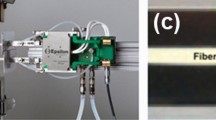Abstract
During hot fire rocket engine testing, non-contacting measurements are superior to bonded gauges because they are immune to burning, shaking loose, or damage due to the harsh testing conditions. Additionally, when compared to instruments which register at single points, Digital Image Correlation (DIC) has the added benefit in that it collects full-field displacement and strain maps over the duration of the test. However, for certain materials and paints under some circumstances of temperature and camera sensitivity, portions of the speckle pattern which were darker at room temperature may emit more light compared to the initially lighter portions of the pattern, resulting in a high temperature pattern which is inverted in comparison with that at room temperature. To address this inversion, a post-processing method is introduced wherein an inverted image containing only emitted light is subtracted from an image containing both emitted and reflected light, thereby generating an un-inverted image. The artificial high temperature image is subsequently correlated against the room temperature image to obtain full-field strains. The subtraction technique is then validated using optical bandpass filters to prevent significant amounts of emitted light from reaching the camera sensor. The two methods are mapped onto common coordinates and shown to produce comparable results. The subtraction method sufficiently mitigates speckle pattern inversion, but its key drawback is that it only works when there is negligible displacement between the subtracted images (i.e. quasi-static loading). It is therefore preferable to eliminate inversion from reaching the camera in the first place by using optical bandpass filters.









Similar content being viewed by others
References
Tenney DR, Starke EA, Newman JC et al (2019) Structural framework for flight II: NASA’s role in development of advanced composite materials for aircraft and space structures. NASA Langley Research Center, Hampton
Lacoste M, Lacombe A, Joyez P et al (2002) Carbon/Carbon extendible nozzles. Acta Astronaut 50:357–367. https://doi.org/10.1016/S0094-5765(01)00178-3
Potapov A, Shtefan Y, Lichman E (2009) Research of material for uncooled nozzle extensions of liquid rocket engines. Acta Astronaut 64:22–27. https://doi.org/10.1016/j.actaastro.2008.06.016
Ajovalasit A (2011) Advances in strain gauge measurement on composite materials. Strain 47:313–325. https://doi.org/10.1111/j.1475-1305.2009.00691.x
Sutton MA, Orteu JJ, Schreier HW (2009) Image correlation for shape, motion and deformation measurements: basic concepts, theory and applications, 1st ed. Springer, New York
Pan B, Qian K, Xie H, Asundi A (2009) Two-dimensional digital image correlation for in-plane displacement and strain measurement: a review. Meas Sci Technol 20:062001. https://doi.org/10.1088/0957-0233/20/6/062001
Pan B (2018) Digital image correlation for surface deformation measurement: historical developments, recent advances and future goals. Meas Sci Technol 29:082001. https://doi.org/10.1088/1361-6501/aac55b
Gradl PR (2016) Digital image correlation techniques applied to large scale rocket engine testing. In: AIAA Propulsion and Power 2016 Conference. Salt Lake City, UT, United States
Mao WG, Chen J, Si MS et al (2016) High temperature digital image correlation evaluation of in-situ failure mechanism: An experimental framework with application to C/SiC composites. Mater Sci Eng A 665:26–34. https://doi.org/10.1016/j.msea.2016.04.021
Gradl PR, Valentine PG (2017) Carbon-carbon nozzle extension development in support of in-space and upper-stage liquid rocket engines. In: 53rd Annual AIAA/SAE/ASEE Joint Propulsion Conference 2017. Atlanta, GA, United States
Valentine PG, Gradl PR (2019) Extreme-temperature carbon- and ceramic-matrix composite nozzle extensions for liquid rocket engines. In: 70th International Astronautical Congress. Washington, DC, United States
Wang W, Xu C, Jin H et al (2017) Measurement of high temperature full-field strain up to 2000°C using digital image correlation. Meas Sci Technol 28:035007. https://doi.org/10.1088/1361-6501/aa56d1
Pan Z, Huang S, Su Y et al (2020) Strain field measurements over 3000°C using 3D-Digital image correlation. Opt Lasers Eng 127:105942. https://doi.org/10.1016/j.optlaseng.2019.105942
Grant BMB, Stone HJ, Withers PJ, Preuss M (2009) High-temperature strain field measurement using digital image correlation. J Strain Anal Eng Des 44:263–271. https://doi.org/10.1243/03093247JSA478
Novak MD, Zok FW (2011) High-temperature materials testing with full-field strain measurement: Experimental design and practice. Rev Sci Instrum 82:115101. https://doi.org/10.1063/1.3657835
Berke RB, Lambros J (2014) Ultraviolet digital image correlation (UV-DIC) for high temperature applications. Rev Sci Instrum 85:045121. https://doi.org/10.1063/1.4871991
Thai TQ, Smith AJ, Rowley RJ et al (2020) Change of exposure time mid-test in high temperature DIC measurement. Meas Sci Technol 31:075402. https://doi.org/10.1088/1361-6501/ab7bbf
Thai TQ (2018) Importance of exposure time on Digital Image Correlation (DIC) at extreme temperatures. All graduate theses and dissertations. 7067, Utah State University
Thai TQ, Hansen RS, Smith AJ et al (2019) Importance of exposure time on DIC measurement uncertainty at extreme temperatures. Exp Tech 43:261–271. https://doi.org/10.1007/s40799-019-00313-3
Thai TQ (2020) Improvement of Ultraviolet Digital Image Correlation (UV-DIC) at extreme temperatures. All graduate theses and dissertations. 7770, Utah State University
Simonsen M (2016) Strain calculation in Vic-3D. Appl Notes. https://correlated.kayako.com/article/42-strain-calculation-in-vic-3d
Archer T, Beauchêne P, Huchette C, Hild F (2019) Global digital image correlation up to very high temperatures with grey level corrections. Meas Sci Technol 31:024003. https://doi.org/10.1088/1361-6501/ab461e
Acknowledgements
This work was funded by a grant from NASA’s Marshall Space Flight Center (award # 80MSFC18M0009) and by the Utah State University Office of Research and Graduate Studies.
Author information
Authors and Affiliations
Corresponding author
Ethics declarations
Conflict of Interest
The authors declare that they have no conflict of interest.
Additional information
Publisher’s Note
Springer Nature remains neutral with regard to jurisdictional claims in published maps and institutional affiliations.
Rights and permissions
About this article
Cite this article
Thai, T., Ruesch, J., Gradl, P. et al. Speckle Pattern Inversion in High Temperature DIC Measurement. Exp Tech 46, 239–247 (2022). https://doi.org/10.1007/s40799-021-00481-1
Received:
Accepted:
Published:
Issue Date:
DOI: https://doi.org/10.1007/s40799-021-00481-1




